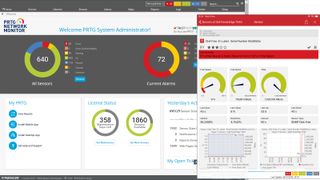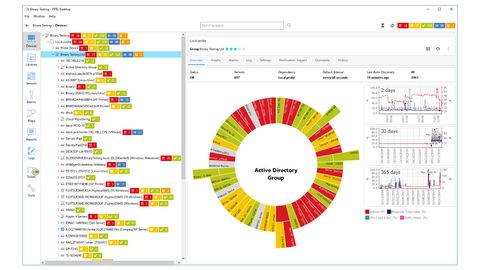IT Pro Verdict
Pros
- +
Wide range of supported sensor types
- +
Smartly-organised console
- +
Outstanding cloud support
Cons
- -
Initial sensor assignment can be excessive
If you have a diverse range of hardware and systems to keep an eye on, Paessler’s PRTG Network Monitor could be the perfect solution. It supports no fewer than 257 sensor types – all of which are included in the standard package – so there’s a good chance it will work with everything on your network.
When we say everything, we mean it. PRTG can keep tabs on servers, switches, routers, Hyper-V, VMware and Citrix XenServer hosts, and plenty of cloud services, business apps and storage providers. And since the software updates itself automatically, you’ll get access to new capabilities as soon as they become available: the latest release brings a new health sensor for Fujitsu’s iRMC server management controller, and even expands into Internet of Things territory with a sensor that collects data from IoT-type devices.
Despite all this, you don’t need a powerful server to install the software. You can run PRTG locally on a modestly specified system, or let Paessler host it in the cloud for you. You don’t need to pay for more features than you need, either, thanks to Paessler’s sensor-based licensing. At first you might be alarmed to see how quickly your sensor count gets eaten up, but this is because when PRTG runs its first discovery, it automatically assigns a range of sensors to each device if finds: our Hyper-V server alone accounted for 51 sensors. Happily, it was easy to review these and delete the ones we didn’t require so they were available for use elsewhere.
The discovery process also sets default alert triggers for each sensor, with alerting options that include mobile push notifications, email, Slack and Microsoft Teams. You can also set alerts to trigger actions such as restarting a service.
The main web console presents not only a complete status overview of your network, but a helpful tree view with all systems tidily organised into hierarchical groups. Moving devices between groups causes them to automatically inherit settings such as discovery schedules and login credentials.

Spotting problems is easy, as sensors are colour-coded to indicate whether they’re in up, down, paused or warning states and you can instantly drill down into them for more detail. You can also pull up views of the top ten sensors for uptime, downtime, CPU usage, fastest website responses and more.
Cloud support is a real strength of PRTG. It includes seven different Amazon CloudWatch sensors, plus others for Google Drive, Dropbox and OneDrive, while the SaaS sensor keeps an eye on cloud application platforms such as Office 365. Server hardware gets plenty of attention, too: along with a global IPMI sensor, PRTG can directly monitor Dell’s iDRAC controllers and report on physical storage devices and power.
As an alternative to using the web console, PRTG also comes with native Windows and macOS desktop apps, which replace the older PRTG Enterprise console. Alongside full device tree views, the Windows app allowed us to manage sensors, edit multiple objects, drag and drop devices into new groups and enable system tray alerts. The free Android and iOS apps are excellent, giving you convenient remote access to the PRTG server and all sensor data. With the app loaded on our iPad, we had no problem connecting to the core PRTG server, pulling up sensor data on selected systems and receiving push notifications when sensor thresholds were breached.
Businesses that want to monitor everything on their network without having to worry about extra costs or unsupported devices will find Paessler’s PRTG Network Monitor a fine choice. It dishes out sensors a bit more liberally than you’ll probably want, but these can be easily moved to where they’re needed, resulting in a monitoring solution that’s not only highly capable but good value.
Dave is an IT consultant and freelance journalist specialising in hands-on reviews of computer networking products covering all market sectors from small businesses to enterprises. Founder of Binary Testing Ltd – the UK’s premier independent network testing laboratory - Dave has over 45 years of experience in the IT industry.
Dave has produced many thousands of in-depth business networking product reviews from his lab which have been reproduced globally. Writing for ITPro and its sister title, PC Pro, he covers all areas of business IT infrastructure, including servers, storage, network security, data protection, cloud, infrastructure and services.



